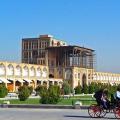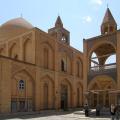Isfahan (or Esfahan) is the capital city of Isfahan Province and is located almost in the center of Iran. Isfahan metropolitan area has an estimated population of about 4,000,000, making it the second most populous metropolitan area in Iran.
The history of Isfahan dates back to ancient times. During the Achaemenid Empire (648–330 BCE), Isfahan was an ethnically and religiously diverse and tolerant city. Isfahan was once one of the largest cities in the world, ranked among places like Athens or Rome and grander than London, Paris and Istanbul. Elegant bridges crossed its modest river, hundreds of domes and minarets punctuated the skyline and polo players dashed across the world's largest square. Isfahan flourished from the early 11th to the 18th century, and particularly during the Safavi dynasty in the 16th & 17th century when it became the capital of the old Persia for the second time.
Even today, the city retains much of its past glory. Many visitors believe Isfahan is the most beautiful city in Iran and one of the most beautiful in the world. It features numerous tree-lined boulevards and flower gardens, miles of beautiful parks along the Zayandeh Rood river; 1300 year-old covered bazaars, bridges, palaces, mosques, and minarets. This led to the Persian proverb "Esfahān nesf-e- jahān ast" (Isfahan is half of the world).
Isfahan's Imam Square, also known as the Naghsh-e Jahan (meaning portrait of the world) Square, is one of the largest city squares in the world and an outstanding example of Iranian and Islamic architecture. Around the square sit a number of world-famous wonders of Islamic architecture. The Imam Square is designated by UNESCO as a World Heritage Site.
The Jameh Mosque of Isfahan, built nearly 1300 years ago, is one of the oldest mosques still standing in Iran, and is also a designated UNESCO World Heritage Site.
In addition to its historical roots, Isfahan is also one of the major educational, cultural, industrial and agricultural centers of Iran. The people of Isfahan are well known for their intellect, adherence to religious values, tenacity, and their high impact within the realm of Iranian art, culture and politics. Different religious minorities, including Christians, Zoroastrians, and Jews have enjoyed a peaceful coexistence with the Muslim population for centuries.
Learn more



The city is located at an altitude of 1590 meters above sea level in the lush plain of the Zayanderud River, at the foothills of the Zagros mountain range. The nearest mountain is Mount Soffeh (Kuh-e Soffeh) which is situated just south of Isfahan. No geological obstacles exist within 90 km north of Isfahan, allowing cool northern winds to blow from this direction. Isfahan has a seasonal climate. It remains hot during the summer with maximum temperature typically around 35 °C (95 °F). However, with low humidity and moderate temperatures at night, the climate can be very pleasant. During the winter, days are mild while nights can be very cold. Snow has occurred at least once every winter.Geography and climate:
Transportation:
By plane:
There are daily flights from Isfahan International Airport to main cities in Iran and a number of international destinations, currently including, Dubai, Kuwait, Istanbul, Najaf, Vienna and there are planned flight to other international destinations.
A taxi ride from Airport to city center costs around 200000 Rls.
By car:
Isfahan is well-served by highways. There are good routes to the capital Tehran, Kashan, Shiraz, Yazd and Ahvaz.
By bus:
Isfahan is well connected to most parts of Iran by bus. There are multiple bus terminals in Isfahan serving Northern, Southern, Western and Eastern parts of the country. There are buses to/from Tehran every 15 minutes and frequent buses to main cities in the country. There is a direct bus service to the Imam Khomeini International Airport.
Get around
View full-screen map for Isfahan
By bus:
It is easy to get around Isfahan by bus at a very reasonable cost. You can buy multi-journey contactless cards at certain bus stop booths or pay the driver directly. Note that there are separate men (front) and women (rear) sections on each bus.
By Metro:
Isfahan Metro is under construction. The first phase of Line 1 was opened in October 2015 and other phases are planned to open soon.
- 620 views
